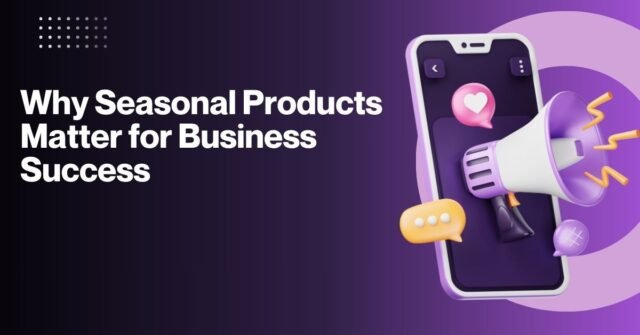Seasonal products often add a sense of excitement and anticipation to our calendars. From pumpkin spice lattes in the fall to beachwear collections in the summer, businesses that successfully incorporate seasonal products often see a surge in sales, customer engagement, and market relevance. But beyond this obvious appeal, why are seasonal products so important?
This blog explores the significance of seasonal products for businesses, the benefits they bring, and how to incorporate them effectively into your strategies, regardless of industry. Whether you’re a small business owner or a marketing professional, you’ll find actionable insights to make seasonal products a key part of your growth strategy.
What Are Seasonal Products?
Seasonal products are items or services specifically designed for a particular time of the year or an occasion. They are closely tied to consumer behaviors and cultural trends. Examples include:
- Holiday Products: Think limited-edition Christmas-themed chocolates or New Year calendars.
- Weather-Driven Products: Items like winter coats, summer sunscreens, or spring gardening tools.
- Event-Based Products: Wedding season services, back-to-school promotions, or festival-specific apparel.
These products align with events, moods, and needs that are unique to specific timeframes, making them highly relevant to consumers when properly marketed.
The Business Benefits of Seasonal Products
Understanding the “why” behind seasonal products can show how they drive business growth and improve brand positioning. Here are the key benefits they offer:
1. Boosted Sales and Revenue
One of the most apparent advantages of seasonal products is their ability to drive sales. Limited-time offerings create urgency among consumers. Whether it’s a Black Friday deal or Valentine’s Day-themed merchandise, seasonal products trigger FOMO (fear of missing out), pushing customers to buy sooner rather than later.
For example:
- Starbucks witnessed a revenue spike when it introduced its now-iconic Pumpkin Spice Latte. It remains one of their most anticipated seasonal offerings.
- Clothing retailers launch special “summer collections” or “winter exclusives” to cater to changing consumer preferences, boosting sales during those periods.
2. Strengthened Customer Engagement
Seasonal promotions often invite higher levels of customer interaction. These products are excellent for marketing campaigns, especially on social media, where consumers love sharing festive moments.

For instance:
- Coca-Cola’s holiday campaigns featuring their signature Santa Claus theme have consistently driven widespread consumer engagement and brand recognition for decades.
- Instagram-ready fall photo ops featuring retailers’ seasonal displays encourage user-generated content and brand mentions.
Seasonal products open opportunities for brands to foster emotional connections with audiences tied to festivities, traditions, or trending themes.
3. Opportunity for Branding and Storytelling
Seasonal offerings allow businesses to tell timely, relevant brand stories. This creates stronger emotional connections with customers and positions the brand as empathetic, modern, and culturally aware.
For example:
- Outdoor apparel brands like Patagonia capitalize on winter to emphasize their products’ durability in extreme conditions while drawing attention to climate change awareness.
- Hallmark, with its seasonal cards and movies, uses key holidays to emphasize family, love, and togetherness as a part of their brand identity.
4. Inventory Management
Seasonal products help streamline inventory and reduce product stagnation. By producing and stocking items with a built-in expiration period tied to a season, businesses can better predict inventory needs, reducing waste.
Retailers like Target use this strategy effectively by ensuring a swift transition from one seasonal category (e.g., Halloween) to the next (e.g., Christmas).
How to Incorporate Seasonal Products Effectively
Creating successful seasonal offerings requires careful planning, strategy, and execution. Here are six actionable tips to make the most of seasonal opportunities.
1. Understand Your Audience’s Seasonal Habits
Dive into customer data to identify purchasing patterns. Use surveys, social media polls, and sales analytics to determine which seasons, holidays, or occasions matter most to your customers.
Actionable Tip:
Track past holiday quarters using analytics tools (e.g., Google Analytics or Shopify dashboards) to see seasonal spikes in searches or purchases on your website.
2. Plan Early and Strategize
Effective seasonal campaigns require thorough preparation. Businesses should carefully plan product design, sourcing, marketing, and rollout timelines well before the seasonal demand kicks in.
Key Considerations:
- Start creating awareness a few months ahead. For example, launch promotions for back-to-school sales in July.
- Avoid releasing seasonal products too early, as premature availability can dilute demand.
3. Create a Sense of Urgency
“Limited-time-only” messaging encourages speedy decision-making from consumers. Highlight deadlines for purchases within marketing materials to increase conversion rates.
Example Phrases:
- “Available until December 31 only!”
- “Grab one while supplies last!”
4. Stay True to Your Brand
Introduce seasonal offerings that align with your existing brand or product categories. If your business specializes in health foods, for example, seasonal products should build on that identity, such as healthy pumpkin-flavored protein bars rather than artificial candy corn.
5. Leverage Digital and Social Media Marketing
Social media platforms are the perfect place to showcase seasonal collections. From Instagram Stories to TikTok trends, creativity knows no bounds!
Ideas for Campaigns:
- Hold a seasonal product giveaway (e.g., “Win our Holiday Gift Box!”).
- Create behind-the-scenes videos of how your seasonal products are made.
- Partner with influencers to create buzz around new offerings.
6. Evaluate Post-Season Performance
Once the seasonal peak has passed, conduct in-depth performance assessments. This includes analyzing sales data, reviewing customer feedback, and evaluating inventory. Identifying wins and areas for improvement will ensure smoother seasonal campaigning in the future.
Challenges to Watch Out For
While seasonal products are beneficial, they aren’t without challenges:
- Overproduction risks leftover inventory or waste, so careful demand forecasting is crucial.
- Misalignment with Timing can backfire. For instance, launching Christmas promotions in October might overwhelm consumers.
- Over-saturation may occur if your competitors release similar seasonal products. Offering unique value propositions helps you stand out.
Seasonal Products as a Key Strategy for Business Growth
Seasonal products are not just novelties; they are strategic tools that can transform customer relationships, expand your brand’s reach, and improve revenue streams. By capitalizing on timely events and addressing trends responsibly, your business can leverage seasonal opportunities as a source of innovation and long-term growth.
Start small if you’re new to seasonal products. Test a few offerings per year, analyze results, and refine your approach over time. The rewards might surprise you—not just seasonally but year-round.
You can Learn more about: Seasonal Marketing Ideas to Transform Your Business Year-Round









